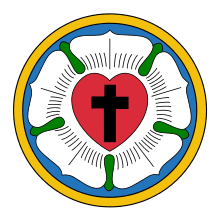Lutheran Free Church
| Part of a series on |
| Lutheranism |
|---|
 |
|
Bible translators
|
|
Theologians |
|
|
The Lutheran Free Church (LFC) was a Lutheran denomination that existed in the United States, mainly in Minnesota and North Dakota, from 1897 until its merger into the American Lutheran Church (ALC) in 1963. The history of the church body predates its official organization, and a group of congregations that did not join the ALC formed the Association of Free Lutheran Congregations.[1]
Background
Georg Sverdrup and Sven Oftedal were two scholars from prominent Haugean families in Norway who came to Augsburg Seminary in Minneapolis, Minnesota, to teach in the 1870s, bringing with them a radical view of Christian education that was centered on Scripture and the simple doctrines of Christianity. The Haugean movement took its name from Norwegian lay evangelist Hans Nielsen Hauge who spoke up against the Church establishment in Norway. Sverdrup and Oftedal had been concerned about hierarchy within the Christian church as well as the study of the Bible. They believed that, according to the New Testament, the local congregation was the correct form of God's kingdom on earth.[2] Their vision was for a church that promoted a “living” Christianity, emphasized an evangelism that would result in changed lives, and enabled the church member to exercise his/her spiritual gifts.
Augsburg was the seminary of the Conference of the Norwegian-Danish Evangelical Lutheran Church of America In 1890, the "Conference" joined with two other Lutheran church bodies to form the United Norwegian Lutheran Church of America (UNLC).
A dispute within the UNLC over which school, Augsburg or St. Olaf, should be the college of the church body led in 1893 to the creation of the Friends of Augsburg. By 1896, Sverdrup, Oftedal, and others felt their beliefs of a "free church in a free land" were being compromised and broke away from the UNLC, forming the Lutheran Free Church in 1897.
The LFC's publishing house was the Messenger Press and its official English language magazine was the Lutheran Messenger started in 1918. During most of its earlier history the church also published a Norwegian language publication named Folkebladet (the People's Paper).
In harmony with its emphasis on utilizing and developing the natural spiritual gifts of all the members of the Church, the LFC gave a freer rein to women within its church body to hold non-ordained ministries, offices, and responsibilities than many of its contemporary Lutheran counterparts.[3] The LFC also strongly emphasized the importance of foreign missions (with missions fields in Madagascar and the Cameroons) and spent more of its financial resources on foreign missions and supported a larger number of foreign missionaries than many of its contemporary Lutheran church bodies of comparable size.
By the 1950s there was a growing movement by many Lutherans throughout the United States to merge smaller Lutheran bodies into larger ones. The Lutheran Free Church joined the American Lutheran Church on February 1, 1963, after votes were held in 1955, 1957, and 1961. In 1988 the ALC itself joined with other Lutheran churches to form the Evangelical Lutheran Church in America (ELCA). About 40 Lutheran Free Churches however did not join the ALC, instead forming the Association of Free Lutheran Congregations (AFLC) in October 1962. Today the AFLC has more than 250 congregations.
Presidents of the LFC
Term of office: one year 1897-1920. Three years 1920-1963
| Name | Term |
|---|---|
| Elias P. Harbo | 1897–1899 |
| Endre E. Gynild | 1899–1901 |
| Elias P. Harbo | 1901–1903 |
| Christopher K. Ytrehus | 1903–1905 |
| Endre E. Gynild | 1905–1907 |
| Elias P. Harbo | 1907–1909 |
| Endre E. Gynild | 1909–1910 |
| Paul Winter | 1910–1912 |
| Endre E. Gynild | 1912–1914 |
| Johan Mattson | 1914–1916 |
| Endre E. Gynild | 1916–1918 |
| Johan Mattson | 1918–1920 |
| Olai H. Sletten | 1920–1923 |
| Endre E. Gynild | 1923–1928 |
| Hans J. Urdahl | 1928–1930 |
| Thorvald O. Burntvedt | 1930–1958 |
| John Stensvaag | 1958–1963 |
Annual Conferences
|
|
References
- ↑ The Lutheran Free Church (Minneapolis: Frikirkens Boghandels Forlag, 1910)
- ↑ Standing Fast in Freedom (The Association of Free Lutheran Congregations)
- ↑ A point stressed on numerous occasions by Gracia Grindal, a professor at Luther Theological Seminary.
Other sources
- Clarence J. Carlsen, The Years of Our Church (Minneapolis, MN: The Lutheran Free Church Publishing Company, 1942)
- Eugene L. Fevold, The Lutheran Free Church: A Fellowship of American Lutheran Congregations 1897-1963 (Minneapolis, MN: Augsburg Publishing House, 1969)
- Aarflot, Andreas Hans Nielsen Hauge, his life and message (Augsburg Publishing House, Minneapolis, MN. 1979)
- Hamre, James S. Georg Sverdrup: Educator, Theologian, Churchman (Northfield, MN: Norwegian-American Historical Association. 1986)
- Loiell Dyrud, The Quest for Freedom: The Lutheran Free Church to The Association of Free Lutheran Congregations (Minneapolis, MN: Ambassador Publications, 2000)
- Augsburg College- The Lutheran Free Church. CLiC Digital Collections.